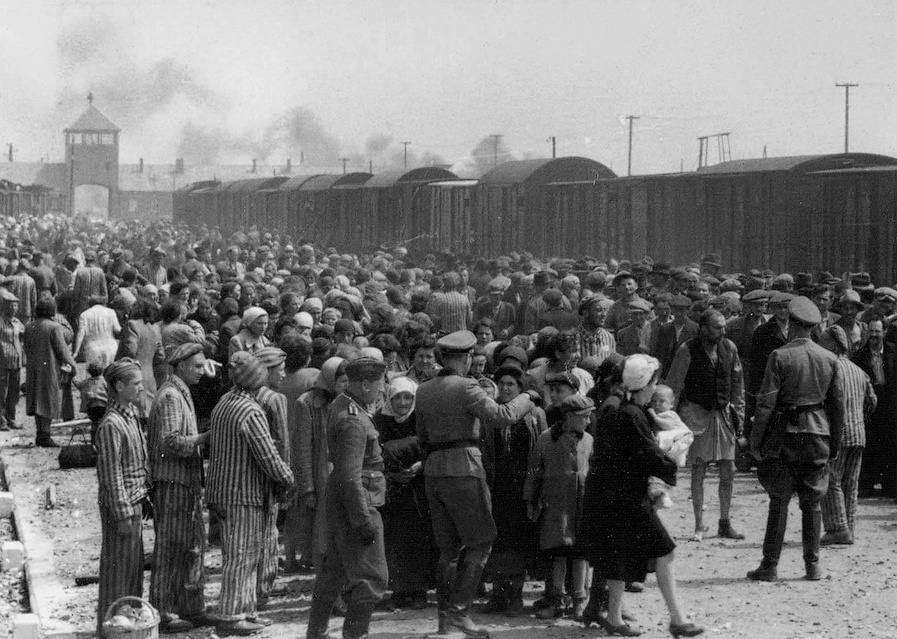Chronology of the Roma Holocaust
Scroll down the page or navigate throughout the years
1933 1935 1936 1938 1939 1940 1941 1942 1943 1944 1945
1935

In many cities within the German Reich, compulsory camps are set up. Two weeks before the opening of the 1936 Olympic Games, hundreds of people are interned in such a camp in the Berlin borough of Marzahn. The camps serve to concentrate, restrict, register and isolate as well as provide a source of forced labour.
1936

In accordance with the Nuremberg laws on race and citizenship (1935), Reich Interior Minister Wilhelm Frick decrees in January 1936: “Alien races include all other races; in Europe, these are, apart from the Jews, as a rule only the Gypsies.” On the basis of this decree, a racist special law is enacted. Those affected are, among other things, forbidden to marry and excluded from certain professions and the German armed forces.
1938

Over 2,000 Sinti and Roma from Germany and Austria, including children aged twelve and older, are seized and taken away to Dachau, Buchenwald, Sachsenhausen, Ravensbrück, Mauthausen and other concentration camps. On orders from Reichsführer-SS and Chief of the German Police Heinrich Himmler, a central office is set up at the Reich Criminal Police Office in Berlin to manage and coordinate the registration and persecution of the Sinti and Roma. In December, Himmler issues a basic decree “to tackle the Gypsy question on the basis of race” with the aim of finding a “final solution to the Gypsy question”. By the end of World War II, the Research Office for Racial Hygiene, which was given the task of registering Roma and Sinti, has prepared some 24,000 “racial expert opinions”. These provide an essential basis for deportation to killing centres.
1939

With the start of World War II, the Reich Security Main Office, which plays a leading role in organizing the genocide, plans the deportation of all those registered as “Gypsies”. In preparing the deportations, the Reich Security Main Office decrees that all those affected “be instructed not to leave their current place of residence until further notice”.
1940

On orders from Himmler, the deportation of entire families from Germany to occupied Poland begins: “The first transport of Gypsies to the General Government, with 2,500 persons… will move out in mid-May.” In camps, and later in ghettos as well, Sinti and Roma are forced to labour under murderous conditions. In many places, they are required to carry special identification papers or wear armbands bearing the letter Z (as in Zigeuner, German for Gypsy).
1941

The systematic mass shooting of Roma starts in the occupied Soviet Union and other occupied territories of south-eastern Europe. A mobile killing unit, a so-called Einsatzgruppe of the Security Police and the Security Service of the SS, reports from the Crimea: “Gypsy question resolved.” Some 5,000 Roma and Sinti are deported from the Burgenland region of Austria to the ghetto at Litzmannstadt (Łódź) in occupied Poland, where more than 600 of them die. The survivors are gassed in specially equipped vans at the Chełmno killing centre in January 1942.
1943

On the basis of a decree issued by Heinrich Himmler on 16 December 1942, the deportation of some 23,000 Sinti and Roma from throughout Europe begins in February. The destination of the transports is a part of the killing centre Auschwitz-Birkenau that has been designated by the SS as the “Gypsy camp”. Within a few months, most die of hunger, disease, or acts of violence by the SS. Numerous children fall victim to the experiments of SS camp doctor Josef Mengele.
1944

On 16 May, many of the 6,000 prisoners still alive in the “Gypsy camp” at Auschwitz-Birkenau resist their imminent murder. Around half of them are deported to other concentration camps for forced labour. The remaining 2,897 survivors – mostly children, women, and elderly people – are murdered in the gas chambers in the night of 2 August and the early morning of 3 August.
Sources:
- Factsheets on Roma History
- United States Holocaust Memorial Museum
- Foundation Memorial to the Murdered Jews of Europe
© photos United States Holocaust Memorial Museum





